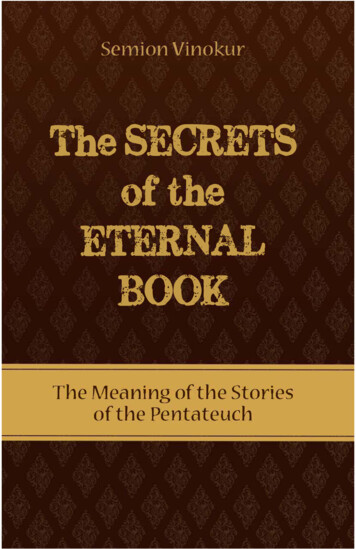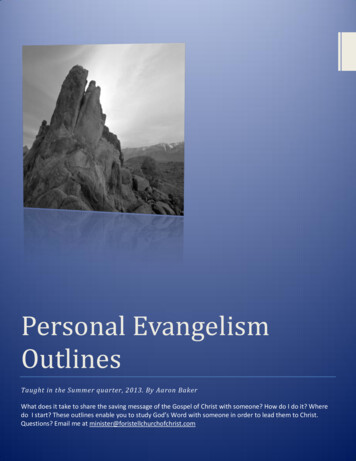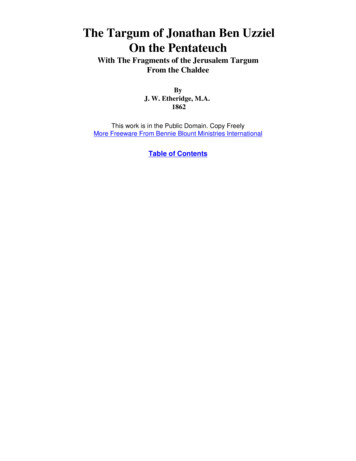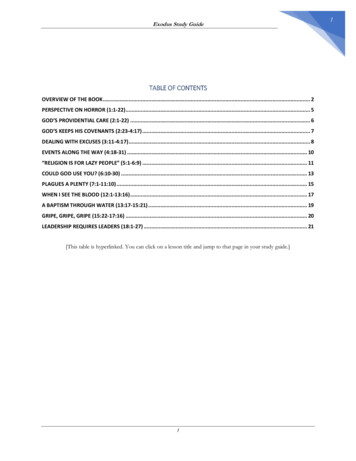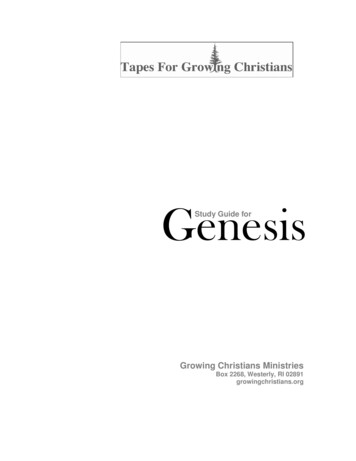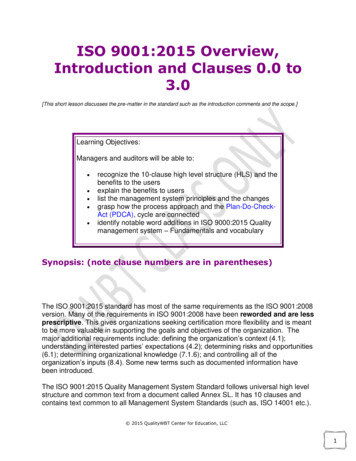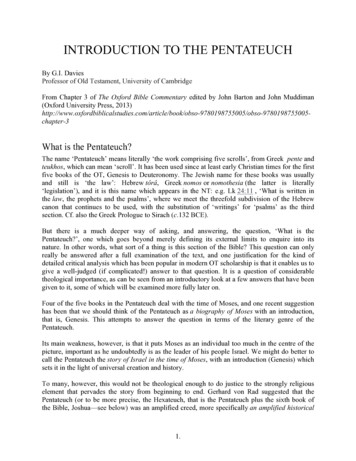
Transcription
INTRODUCTION TO THE PENTATEUCHBy G.I. DaviesProfessor of Old Testament, University of CambridgeFrom Chapter 3 of The Oxford Bible Commentary edited by John Barton and John Muddiman(Oxford University Press, 3What is the Pentateuch?The name ‘Pentateuch’ means literally ‘the work comprising five scrolls’, from Greek pente andteukhos, which can mean ‘scroll’. It has been used since at least early Christian times for the firstfive books of the OT, Genesis to Deuteronomy. The Jewish name for these books was usuallyand still is ‘the law’: Hebrew tôrâ, Greek nomos or nomothesia (the latter is literally‘legislation’), and it is this name which appears in the NT: e.g. Lk 24:11 , ‘What is written inthe law, the prophets and the psalms’, where we meet the threefold subdivision of the Hebrewcanon that continues to be used, with the substitution of ‘writings’ for ‘psalms’ as the thirdsection. Cf. also the Greek Prologue to Sirach (c.132 BCE).But there is a much deeper way of asking, and answering, the question, ‘What is thePentateuch?’, one which goes beyond merely defining its external limits to enquire into itsnature. In other words, what sort of a thing is this section of the Bible? This question can onlyreally be answered after a full examination of the text, and one justification for the kind ofdetailed critical analysis which has been popular in modern OT scholarship is that it enables us togive a well-judged (if complicated!) answer to that question. It is a question of considerabletheological importance, as can be seen from an introductory look at a few answers that have beengiven to it, some of which will be examined more fully later on.Four of the five books in the Pentateuch deal with the time of Moses, and one recent suggestionhas been that we should think of the Pentateuch as a biography of Moses with an introduction,that is, Genesis. This attempts to answer the question in terms of the literary genre of thePentateuch.Its main weakness, however, is that it puts Moses as an individual too much in the centre of thepicture, important as he undoubtedly is as the leader of his people Israel. We might do better tocall the Pentateuch the story of Israel in the time of Moses, with an introduction (Genesis) whichsets it in the light of universal creation and history.To many, however, this would not be theological enough to do justice to the strongly religiouselement that pervades the story from beginning to end. Gerhard von Rad suggested that thePentateuch (or to be more precise, the Hexateuch, that is the Pentateuch plus the sixth book ofthe Bible, Joshua—see below) was an amplified creed, more specifically an amplified historical1.
creed, as will be seen in more detail later. The implication is then that the Pentateuch is a productand an expression of faith—it is preceded as it were by an implicit ‘I believe in God who ’, it isa confessional document, as one might put it. Of course the adjective ‘historical’ before ‘creed’raises some problems, for example whether the story which the Pentateuch as a whole tells is realhistory, a question whose answer has important theological implications which critics of von Radwere quick to point out. But there are also problems of a simpler kind which relate specifically toits accuracy as a description of Genesis 1–11 . Von Rad was, for much of his scholarly career,fascinated by the historical focus of so much of Israel's faith, and he tended to overlook or playdown its teaching about God the Creator. This may well have been due to an understandablewish on his part not to allow a foothold in the OT for crude Nazi ideas about racial supremacygrounded in the order of creation which were current at the time he wrote his earliest works onthe Hexateuch. It is, nevertheless, necessary to emphasize that the beginning of Genesis is notabout history in the ordinary sense of that word, or indeed in any sense, and the idea that thePentateuch is a ‘historical’ creed is in danger of losing sight of the important theologicalstatements about creation in those chapters.A different way of representing the theological character of the Pentateuch is of course thetraditional Jewish expression: the law. This is as characteristic of Judaism as von Rad's emphasison faith is characteristic of his Lutheranism. If it seems at first sight to focus too much on thesecond half of the Pentateuch, where the laws are concentrated, and to give insufficient attentionto the ‘story’ character of the earlier books, it is worth saying that this problem has not escapedthe notice of Jewish commentators, and a very early one, Philo of Alexandria, in the first centuryCE, had what he thought was a perfectly satisfactory answer to it. It is that while written law isindeed mainly found in the later books of the Pentateuch, the personalities who appear inGenesis, for example, constitute a kind of ‘living law’, since through their example, and in someless obvious ways, it was God's intention to regulate human behaviour, just as he does later bythe written law. Another way of making the description ‘law’ more widely applicable involvesgoing back to the Hebrew term tôrâ. Although commonly translated ‘law’, its original meaningis something like ‘instruction’, and it could be used of other kinds of instruction as well as law inthe strict sense. For example, the word tôrâ is found in Proverbs, where the context shows thatthe reference is to the kind of teaching contained there, not to the law as such. If we use tôrâ as adescription for the Pentateuch in this more general sense of ‘teaching’ or ‘instruction’, it caneasily embrace the non-legal parts of these books as well as the legal ones. On the other hand,while tôrâ understood in this wider way does preserve an important truth about the Pentateuch(especially if it is thought of as ‘The Teaching’, with a capital T), it is in danger of being toovague a description to identify its distinctive character within the OT.Another theological definition, which has the merit of combining the advantages of the last two,is to call the Pentateuch a covenant book, a document which presents the terms of God'srelationship to his people, in the form of his promises to them and the laws which he requiresthem to obey. The support of the apostle Paul can probably be claimed for this description, forwhen he speaks of ‘the old covenant’ in 2 Cor 3:14 it is very likely that he means specifically thePentateuch. He is clearly thinking of a written document, because he refers to the ‘reading’ of theold covenant, and the substitution of the expression ‘whenever Moses is read’ in the followingverse points firmly to the Pentateuch (for ‘Moses’ as shorthand for ‘the books of Moses’ seeLk 24:27 ). A somewhat earlier Jewish reference to the Pentateuch as ‘the book of the covenant’2.
occurs in 1 Macc 1:57 . Despite the antiquity and authority of this description, it scarcely doesjustice to the narrative element in the Pentateuch, especially in Genesis.A description which combines the literary and the theological aspects has been proposed byDavid Clines: he regards the Pentateuch as the story of the partial fulfilment of the promise to thepatriarchs. This has the great advantage of highlighting the important theological theme ofpromise in Genesis, and of showing how Genesis is linked to the later books theologically, andnot just by the continuation of the story. But of course it says nothing about Gen 1–11 , and onemay wonder whether it takes enough account of the vast amount of legislative material inLeviticus and Deuteronomy especially.One might legitimately wonder whether there can be any brief answer to the question which isnot open to some objection or another! If nothing else these quite different descriptions, and thecomments on them, should have shown that the Pentateuch is a many-sided piece of literatureand one which has features which appeal to a variety of religious and other points of view. Thefinal description that I will mention is that the Pentateuch is an incomplete work, a torso, becausethe story which it tells only reaches its climax in the book of Joshua, with the Israelites' entryinto the land of Canaan. For von Rad, as we saw, the real literary unit is the ‘Hexateuch’, ‘the sixbooks’, and he had many predecessors who also took this view. It was especially popular amongthe source-critics of the late nineteenth and early twentieth centuries, who believed (as some stilldo) that the sources out of which the Pentateuch was composed were also used by the editor oreditors who composed Joshua. It is less popular today, because Joshua is generally treated as partof the long historical work which extends to the end of 2 Kings, the Deuteronomistic History. Infact since Deuteronomy formed the introduction to that work and, even when taken alone, itsconnection with the first four books of the Bible can seem very weak, some scholars thereforespeak of ‘the Tetrateuch’, that is the four books from Genesis to Numbers, as the primary literaryunit at the beginning of the Bible. From this point of view the Pentateuch would be not so mucha torso as a hybrid, the combination of one literary work with the first section of another. Ifnothing else this view serves to underline the differences in character, concerns, and origin ofDeuteronomy, as compared with the earlier books. Yet those differences should not beexaggerated, and it can be argued that Deuteronomy belongs as much with the Tetrateuch as withthe books that follow it, and when we come to look at the theology of the Pentateuch in moredetail that will become clearer.The Documentary HypothesisTo make further progress with our question, ‘What is the Pentateuch?’, we need to dig deeperand consider more closely how it came to exist and what kinds of material it is made up of. Auseful way into such study is to review, critically where necessary, the main directions whichPentateuchal scholarship has taken over the past century and a half (see also Clements 1997 : ch.2).The year 1862 was auspicious for the development of Pentateuchal study in England andGermany. It was in that year that Julius Wellhausen went, at the age of 18, as a new student tothe German university of Göttingen to study theology. That same year a young British student, T.3.
K. Cheyne, was also in Göttingen, and he was to play an important part in bringing Wellhausen'slater ideas to prominence in Britain—he became a professor at Oxford. The year 1862 was alsowhen a series of books by John Colenso, a Cambridge mathematician, began to be published, andso brought critical OT scholarship very much into the public eye in Britain only shortly after thepublication of Charles Darwin's Origins of Species and the collection called Essays and Reviews.And yet by 1862 the critical study of the Pentateuch was already some 150 years old.There is no need to amplify this statement here—the details are in most Introductions to theOT—except to say that particularly since about 1800 strenuous efforts had been made, chiefly inGermany, to discover the process by which the Pentateuch had reached its present form, and thatat the beginning of the 1860s the leading scholars held to what was known as the SupplementaryHypothesis (Ergänzungshypothese). According to this, the original core of the Pentateuch was adocument known as the Book of Origins (Das Buch der Ursprünge), which was put together by apriest or Levite in about the time of King Solomon. A distinguishing mark of this book was thatin Genesis and the beginning of Exodus (up to ch. 6 ) it avoided using the name YHWH for God,and employed other words, especially ělōhîm, which means ‘God’, instead. This core, it washeld, was expanded in the eighth century BCE, the time of the first great classical prophets, bythe addition of stories and other matter in which the name YHWH was freely used from the verybeginning. Later still, in the time of Jeremiah (7th cent.), the work was further supplemented bythe addition of the major part of Deuteronomy and shorter sections with a similar spiritelsewhere, and so the Pentateuch reached its present form, before the Babylonian Exile.Wellhausen's teacher at Göttingen, Heinrich Ewald, had played an important part in thedevelopment of this theory and still held to it in its essential points in 1862, though not with therigidity of some of its other adherents.But changes were in the air. An important challenge to this theory had already been made by thepublication in 1853 of a book by Hermann Hupfeld. Its main theses were: (1) that the so-called‘original core’ contained some passages which were of later origin than the rest and representeda first stage of expansion of the core; and (2) that both these later passages and the passageswhich the Supplementary Hypothesis itself had distinguished from the core were not fragmentspicked up from all over the place but had been parts of large pre-existing narrative compositionswhich the compilers of the Pentateuch had drawn on as sources.Hupfeld thus did two things. He refined the analysis of the Pentateuch into its component parts,which were now seen to be not three but four in number, and he replaced the idea of theexpansion of an original core with a truly documentary theory of Pentateuchal origins. His fouroriginally independent source-documents correspond closely in extent to those of later theories,three parallel narrative sources and the law-code of Deuteronomy (with some other passagesrelated to it). His oldest narrative corresponds closely to what is now called the Priestly Work(P), the remainder of the Book of Origins is the later Elohist (E), and the source which uses thename YHWH is the Yahwist (J). Hupfeld did not depart from the dominant view at the timeabout the relative ages of the materials in these sources, and his position can be represented interms of the modern symbols for them as P-E-J-D (for a fuller account of the sources as laterunderstood see sections c.7 and G).4.
Hupfeld's new ideas did not succeed in displacing the dominant Supplementary Hypothesis, atany rate not immediately. But some time before 1860 Ewald had recognized the existence of asecond Elohist and the character of J and E as continuous sources—which places him very closeto Hupfeld. A. Knobel, though less well-known, had reached similar conclusions independentlyof Hupfeld about the same time, and over a larger range of texts. His work is ignored in mostmodern accounts of the history of Pentateuchal criticism (though not by Wellhausen) anddeserves greater recognition. These scholars brought the analysis of the Pentateuch to a statewhich received only relatively minor modification at the hands of those such as Wellhausen,whose work was to become the classical account of Pentateuchal origins and indeed remained sountil very recently. Hupfeld's contribution at least was fully recognized: Wellhausen, forexample, wrote in his own work on the composition of the Hexateuch: ‘I make Hupfeld in everyrespect my starting-point.’ Where he and subsequent scholarship departed from Hupfeld was inthe chronological order in which the sources were to be placed.Two changes were in fact made. One, the placing of the YHWH-source—what we now call J—before the second Elohim-source—what we now call E—did not make a fundamental differenceto the time at which either source was thought to have been written, and we shall not spend longon it. Once Hupfeld had made the separation between E and P it was really inevitable, as it wasthe supposed antiquity of the P texts which had led to the idea that the Book of Origins was theearliest source. When E was detached from this, it could easily be seen that in certain respects ithad a more sophisticated approach to religion than the rather primitive J, and so it was natural todate it a little later.The second change in order was much more decisive, in fact it was quite revolutionary.According to both the Supplementary Hypothesis and Hupfeld's theory, the oldest part of thePentateuch was a Book of Origins that began with the account of creation in Gen 1 and includedmost of the priestly laws in Exodus, Leviticus, and Numbers. Doubts about the antiquity of thesetexts had already been expressed in the 1830s, but detailed critical arguments only began toappear in the early 1860s. One can see this in the work of the Dutch scholar Abraham Kuenen(1828–91), whose Introduction to the OT began to be published in 1861. Kuenen, who acceptedHupfeld's division of the Book of Origins into earlier and later layers, also held that the priestlylaws in the supposedly earlier layer were not in fact all ancient but had developed over a longperiod of time, some of them being later in date than Deuteronomy. An even more radicalconclusion had been reached by a German schoolteacher, Karl Heinrich Graf, who on 7 October1862 wrote to his former OT professor, one Eduard Reuss, ‘I am completely convinced of thefact that the whole middle part of the Pentateuch [apparently Exodus 25to the end of Numbers] ispost-exilic in origin,’ i.e. it all belongs to the final, not the first, stage of the growth of thePentateuch, after the writing of Deuteronomy. Wellhausen himself, looking back on his earlystudent days, also in the early 1860s, wrote that he had been puzzled at the lack of reference tothe allegedly very old priestly laws in the early historical books such as Samuel and Kings and inthe prophets, though he had no idea at the time why this was. It was not until 1865 that thesevery new ideas came out into the open, when Graf published his views in book form. But whilehe maintained that all the legal parts of the Book of Origins were post-exilic in origin, he stillheld to the traditional early date for its narratives. In response to the appearance of Graf's bookKuenen now argued that the Book of Origins could not be divided up in this way, because thenarratives were intimately related to the laws; so, if (as Graf had so powerfully demonstrated) the5.
laws were late in origin, the narratives associated with them in the ‘earlier’ part of the Book ofOrigins must be late too. Graf's letter to Kuenen accepting the validity of this point survives—itis dated 12 Nov. 1866—and subsequently Graf put this change of mind into print in an article inwhich he responded to various criticisms of his book, though the article only came out in 1869after Graf's death. In this way the order (as represented by the modern symbols) P-E-J-D ofHupfeld was transformed into the J-E-D-P that became standard.It is clear that Abraham Kuenen played a very important part in the development of this revisedtheory, although it (like Knobel's contribution) is often overlooked. What is interesting is thatKuenen gave a great deal of the credit for the contribution which he himself was able to make toJohn Colenso's series of volumes entitled The Pentateuch and The Book of Joshua CriticallyExamined. These books were one reason why an attempt was made to depose Colenso from thesee of Natal, which he held, an attempt which was only the beginning of a long wrangle in theAnglican Church in South Africa. Much of what Colenso wrote merely echoed what was alreadybeing done in Germany, but in the first volume of the study he presented what seemed to him tobe a devastating attack on the genuineness of the narratives of the Book of Origins andparticularly the large numbers which they give for the participants in the Exodus (e.g. Ex 12:37 ),the very thing which had seemed to others a guarantee of the accuracy and antiquity of thesource; on the contrary, argued Colenso, it was quite impossible that the numbers could representreal historical facts: they must be fictional. This argument so impressed Kuenen that he found nodifficulty at all in regarding those narratives, as well as the priestly laws which Graf hadexamined, as a late and artificial composition.It is evident from all this that the classical documentary theory of Pentateuchal origins owes littleor nothing, as far as its origin is concerned, to Wellhausen: this was mainly the work of Hupfeld,Graf, and Kuenen, themselves of course building on much earlier work. To call it ‘theWellhausen theory’, as is often done, is a misnomer, though a revealing one. What the newtheory still needed, and what Wellhausen was to provide, was a presentation of it which wouldconvince the many scholars who still held either to the Supplementary Hypothesis or toHupfeld's version of the documentary theory. The work in which Wellhausen did this sosuccessfully was originally called History of Israel. Volume I (Geschichte Israels I)—when nofurther volumes appeared this was changed to Prolegomena to the History ofIsrael (Prolegomena zur Geschichte Israels)—and it was published in 1878. It is still worthreading and its thorough attention to detail, its treatment of evidence from all parts of the OT,and the force and vigour of its arguments still make a strong impression on the reader.Two criticisms are often made of it. The first is that it embodies a Hegelian view of historywhich has been imposed upon the data of the OT (so e.g. W. F. Albright and R. K. Harrison).This is not justified as a criticism of Wellhausen's method of working, whatever similarities maybe traced between some of his conclusions and those of Hegel-inspired history-writing. It is acomplicated issue but essentially it seems that what Wellhausen did was to approach thePentateuch as a secular ancient historian would approach his primary sources in an effort todiscover their character and closeness to the events described: his presuppositions and methodsare those of a historian rather than those of a philosopher, and not significantly different fromthose with which more recent historians have worked. Where he does refer to Hegel once itseems to be an implied criticism. The other criticism is that Wellhausen presented his theory in6.
isolation from knowledge of the ancient Near East, which makes it of no more than antiquarianinterest: so Harrison again and especially K. A. Kitchen. Wellhausen did not of course have thebenefit of knowing many of the archaeological discoveries of subsequent years, and what he didknow he did not regard as of primary importance for interpreting the OT (unlike Gunkel: seebelow). But the main structure of his source-critical arguments has seemed to most subsequentscholars to be unaffected by these discoveries, rightly in my opinion. Where they have departedfrom them it has been because they sensed weaknesses in his treatment of the OT evidence, andnot because of fresh evidence from the ancient Near East.This brief historical introduction to the origins of the so-called Graf–Wellhausen theory aboutthe sources of the Pentateuch should have removed some misconceptions about it, and inparticular it has shown that far from being the product of one man's mind it was arrived atthrough a process of research and discussion which lasted over several decades and involved anumber of different scholars in several countries. But it also begins to open up a topic of quitecentral importance at the present time when some very searching questions are once again beingasked about the validity of what, for brevity, we may continue to call Wellhausen's theory.The Logic of Source-CriticismIt is in fact possible to distinguish, logically at least and to some extent chronologically as well,four stages in the argument which led to the formulation of Wellhausen's account of the originsof the Pentateuch, and if we define them appropriately we shall find that they are quite generallyapplicable to all attempts to analyse the Pentateuch into its constituent parts, and indeed to allattempts at discovering what sources were used in biblical and other writings.The first step was the acceptance that an enquiry into the sources of the Pentateuch waspermissible at all, i.e. that it was not ruled out by the tradition which regarded Moses as theauthor of the whole Pentateuch. This tradition goes back to the NT and contemporary writings,though it is probably not implied by anything in the OT text itself. Clearly if this tradition is notopen to question, there is little room for Pentateuchal criticism of any kind: one could onlyenquire into the sources that Moses may have used for the writing of Genesis, which is exactlywhat one early work of criticism, published in 1753, purported to uncover (JeanAstruc's Conjectures sur les mémoires originaux dont il paroit que Moyse s'est servi pourcomposer le livre de la Genèse). The reasons for questioning the tradition of Mosaic authorshipof the Pentateuch are broadly of two kinds: (1) the relatively late date of the first appearance ofthis tradition (not at any rate before the Babylonian exile); (2) various data in the Pentateuchitself which seem to be inconsistent with it: an obvious one is the account of Moses' death(Deut 34 ).The second step was the analysis of the text, the demonstration of its lack of unity in detail. Inthe eighteenth century, well before the formulation of the Wellhausen theory, theories had beendeveloped to account for what seemed to be signs of composite authorship, or the use of sources.Some passages, such as the Flood Story, appeared to arise from the combination of twooriginally separate accounts of the same event. In other cases it seemed unlikely or evenimpossible that two separate passages could have belonged to the same continuous account, the7.
two creation stories for example. In the history of Pentateuchal criticism the distinction betweenthis, analytical, stage of the enterprise and the next stage, synthesis or the attribution of passagesor parts of passages to a particular source or layer of the Pentateuch, has not always beencarefully observed. Indeed a clear distinction is perhaps not to be found before the handbook ofWolfgang Richter (Exegese als Literaturwissenschaft, 1971). But the two operations can andshould be regarded as separate. To put it in a quite general formula: if ABCD represents a sectionof the Pentateuch, the assertion that A is of separate origin from B and that C is of separate originfrom D is one thing; but the question of whether A belongs to the same source as C or D orneither, for example, is another question, and different answers to it will produce differenttheories about the larger sources of the Pentateuch.So on what basis is it argued that the Pentateuch is of composite origin? Four main kindsof criteriahave commonly been used:1. Repeated accounts of the same action or story.2. The occurrence of statements (or commands) that are incompatible or inconsistent witheach other.3. Vocabulary and style—the use of different words for the same thing, including e.g.different names for God; and variations of style.4. The appearance of different viewpoints on matters of religion in particular, but also onother matters.Two observations on these criteria should be made at this stage: their use will be clarified by anexample later on.1) The argument for disunity is strongest when several of these criteria occur together—sofor example in the analysis of Gen 1–3 .2) In recent years it has been generally realized that criteria 3 and 4 are of far less value foranalysis, at least when they occur alone, than 1 and 2. Variations in relation to 3 and 4may perfectly well occur within a single account (so Noth 1972 and Westermann 1984 ).In fact it is much more at the next, constructive, stage that such factors enter in, bysuggesting which of the various fragments into which the Pentateuch has been analysedhave a common origin, i.e. belong to the same source or layer.The third step is the development of hypotheses about the major constituent parts of thePentateuch and their interrelation. Various models are possible, of which the idea that a numberof independent source-documents have been combined is only the best-known because it is thepattern exemplified by the classical Documentary Hypothesis of Graf, Kuenen, and Wellhausen.Other ‘models’ are possible, however, and indeed have been tried, such as that the Pentateuch issimply a conglomeration of small units put together by an editor (the Fragmentary Hypothesis)or that an original core was amplified by the addition of fresh material, either material that hadpreviously existed independently as small units or new material that was composed for the firsttime for the purpose of modifying the existing core (a Supplementary Hypothesis such as thatwhich was dominant in the middle of the 19th cent.). It is also possible, and in fact commontoday, to have a combined theory which exhibits features of all three models.8.
With all of these models (except the Fragmentary theory) there is the problem of attribution,deciding what material belongs to the same source or stage of supplementation. Sometimes thiscan be determined by what we may call narrative continuity: i.e. an episode in the storypresupposes that an earlier part of the story has been told in a particular way. For example,Gen 9:6 , ‘Whoever sheds the blood of a human, by a human shall that person's blood be shed;for in his own image God made humankind,’ clearly presupposes the account of the creation ofhuman beings in Gen 1:26–7 (note the reference to ‘in his own image’), rather than that inGen 2:7 , and so they presumably belong to the same source or layer. Fortunately the character ofthe Pentateuch is such that this kind of argument can quite often be used. Where it cannot, onemust have recourse to such factors as agreement over criteria such as 3 and 4 at c.2 above toargue that sections of the Pentateuch have a common source.The fourth step is that of arranging the sources (or supplements) in chronological order anddating them. It is in this area that Graf, Kuenen, and Wellhausen made a real innovation. Inrelation to c. 1, 2, and 3 they did little more than refine the results of their predec
unit at the beginning of the Bible. From this point of view the Pentateuch would be not so much a torso as a hybrid, the combination of one literary work with the first section of another. If nothing else this view serves to underline the differences in character, concerns, and origin of Deuteron



